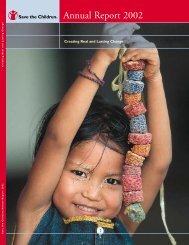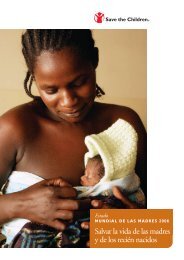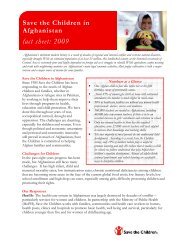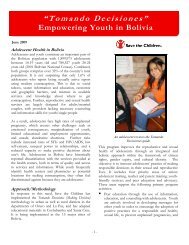The Power and Promise of Girls' Education - Save the Children
The Power and Promise of Girls' Education - Save the Children
The Power and Promise of Girls' Education - Save the Children
You also want an ePaper? Increase the reach of your titles
YUMPU automatically turns print PDFs into web optimized ePapers that Google loves.
Bridging <strong>the</strong><br />
Technology Gap in<br />
<strong>the</strong> United States<br />
While girls in <strong>the</strong> United States typically perform better<br />
academically – <strong>and</strong> graduate in higher numbers – than<br />
boys, a significant gender gap has developed between<br />
boys <strong>and</strong> girls in <strong>the</strong> critical areas <strong>of</strong> science, math <strong>and</strong><br />
technology.<br />
Starting in middle school <strong>and</strong> throughout high school,<br />
girls generally have less access to technology <strong>and</strong> less<br />
interest in math, science <strong>and</strong> computer courses. Boys<br />
consistently outperform girls in <strong>the</strong>se courses, even<br />
though it is estimated that by 2010, 65 percent <strong>of</strong> all<br />
jobs will require <strong>the</strong>se skills. 49<br />
How do we close <strong>the</strong> gap? Experts say we must do<br />
more to train teachers at all levels to encourage girls<br />
to change <strong>the</strong>ir attitudes toward science, math <strong>and</strong><br />
technology.<br />
Many girls in middle school <strong>and</strong> high school have a<br />
stereotypical view <strong>of</strong> technology as a male occupation,<br />
which reinforces <strong>the</strong>ir reluctance to consider careers in<br />
<strong>the</strong>se areas. 50 Additionally, <strong>the</strong> myth that “math, science<br />
or technology are not for girls” remains prevalent<br />
among both male <strong>and</strong> female students throughout <strong>the</strong><br />
country. 51 By eighth grade, across all racial <strong>and</strong> ethnic<br />
groups, twice as many boys as girls are interested in<br />
careers involving math <strong>and</strong> science. 52<br />
With proper training, teachers can play a key role in<br />
breaking down cultural stereotypes <strong>and</strong> building selfconfidence<br />
among girls to encourage more <strong>of</strong> <strong>the</strong>m to<br />
pursue careers in science <strong>and</strong> technology.<br />
Roadmap to a Brighter Future:<br />
What you might see if you visited a school in <strong>the</strong> United States<br />
that had achieved gender equity.<br />
• Displays on bulletin boards, posters <strong>and</strong> o<strong>the</strong>r school<br />
decorations that feature an appropriate balance between<br />
girls <strong>and</strong> boys<br />
• Greetings <strong>and</strong> messages posted on walls that are equally<br />
inviting to girls <strong>and</strong> boys<br />
• An appropriate balance between girls <strong>and</strong> boys who receive<br />
public praise <strong>and</strong> rewards for academic excellence or<br />
extracurricular achievement<br />
• Classes, courses or programs that have achieved gender<br />
balance (meaning that no one sex represents more than<br />
70 percent <strong>of</strong> enrollment)<br />
• St<strong>and</strong>ards regarding appropriate or inappropriate student<br />
behavior do not place a disproportionate share <strong>of</strong><br />
responsibility on ei<strong>the</strong>r boys or girls<br />
• School discipline practices <strong>and</strong> enforcement policies are<br />
administered fairly <strong>and</strong> even-h<strong>and</strong>edly without unduly<br />
burdening ei<strong>the</strong>r boys or girls<br />
• An appropriate balance between men <strong>and</strong> women who act<br />
as teachers, mentors <strong>and</strong> role models<br />
• Classroom practices with supporting messages to make it<br />
clear to students <strong>and</strong> parents that teachers hold equally high<br />
academic achievement expectations <strong>of</strong> both girls <strong>and</strong> boys<br />
Adapted from <strong>the</strong> WEEA Equity Resource Center's Resources to Infuse Equity,<br />
http://www2.edc.org/WomensEquity/resource/title9/t9faq.htm (2002)<br />
<strong>Save</strong> <strong>the</strong> <strong>Children</strong> recognizes <strong>the</strong> problem. In many <strong>of</strong> its<br />
after-school literacy programs in rural communities<br />
throughout <strong>the</strong> United States, <strong>Save</strong> <strong>the</strong> <strong>Children</strong> works<br />
to provide both girls <strong>and</strong> boys access to computers –<br />
<strong>and</strong> basic skills on how to use <strong>the</strong>m – as part <strong>of</strong> its<br />
successful efforts to improve reading skills among rural<br />
children <strong>and</strong> youth.<br />
22<br />
THE POWER AND PROMISE OF GIRLS’ EDUCATION







![View full document [PDF 3.39 MB] - PreventionWeb](https://img.yumpu.com/27308954/1/190x245/view-full-document-pdf-339-mb-preventionweb.jpg?quality=85)









